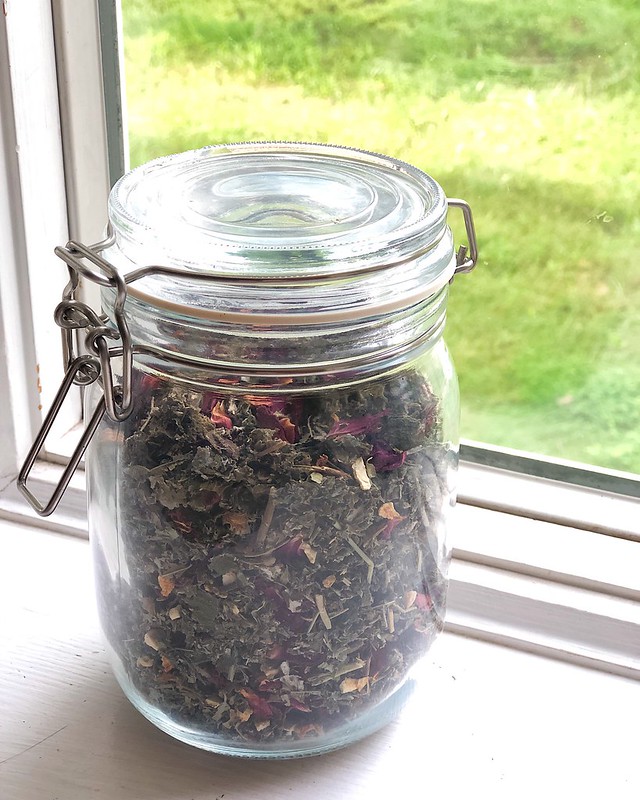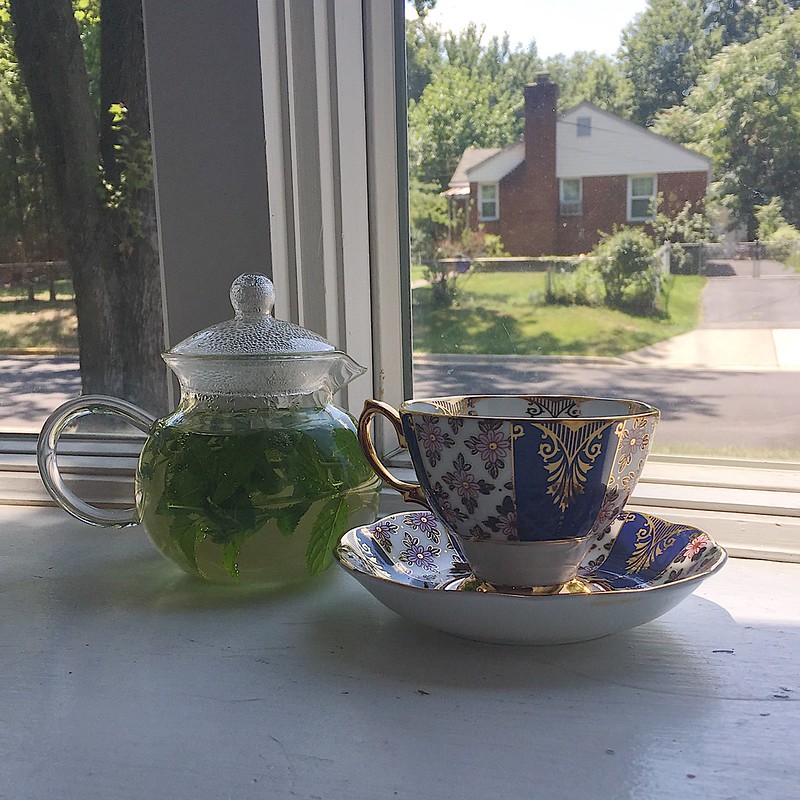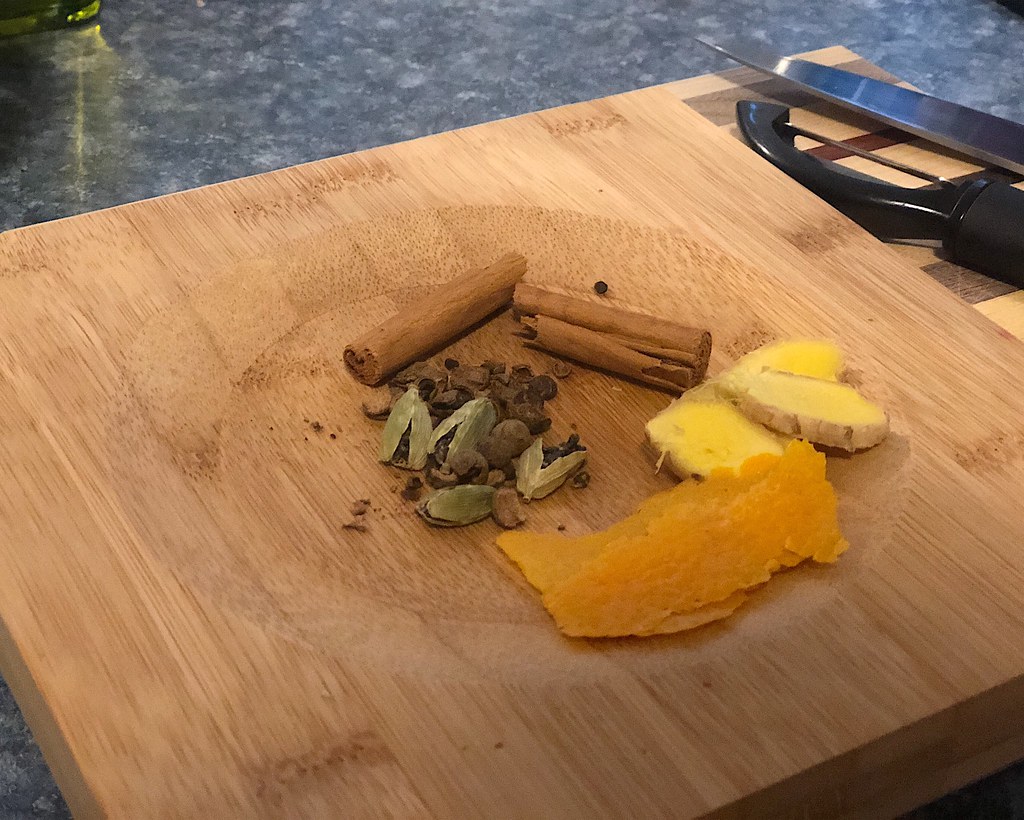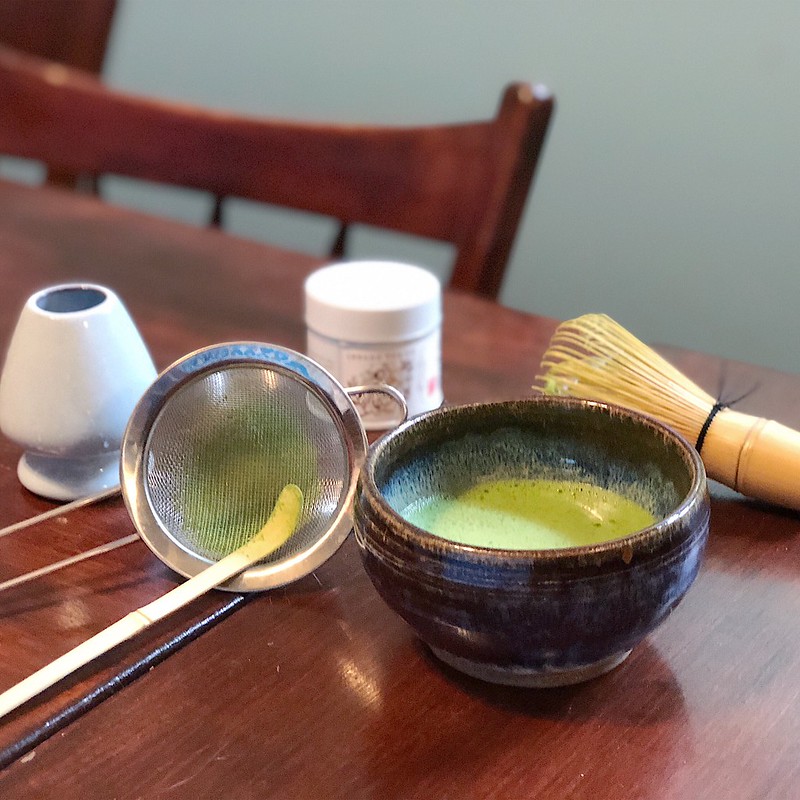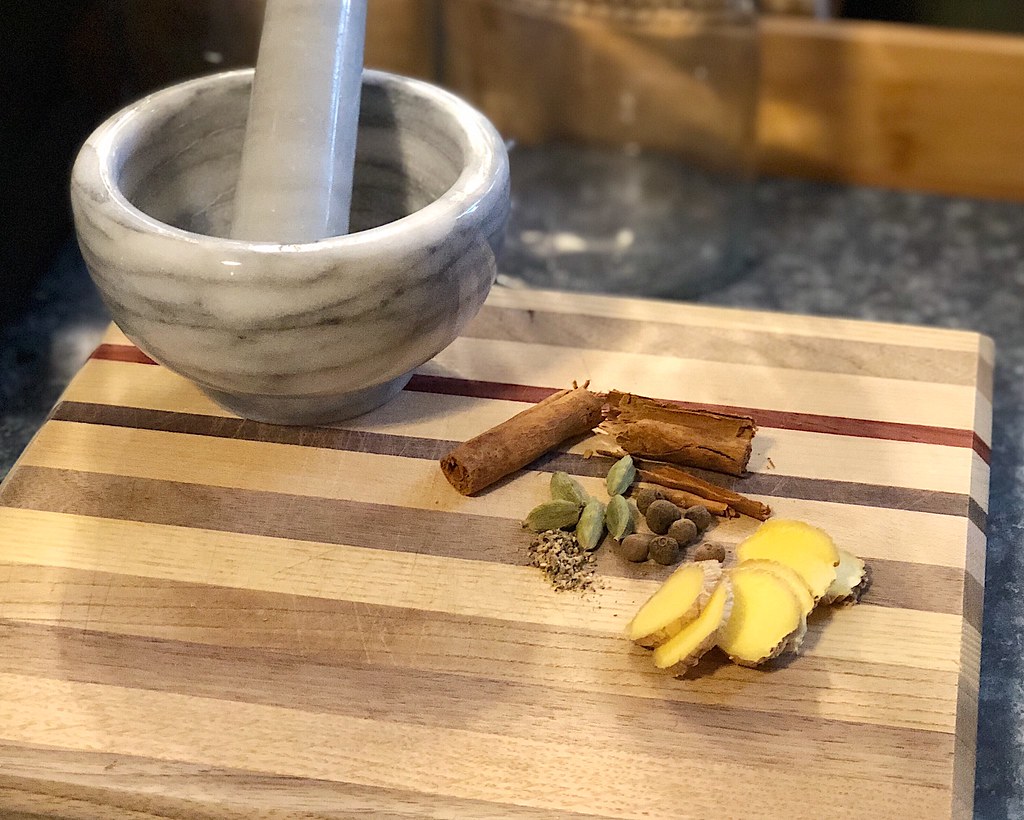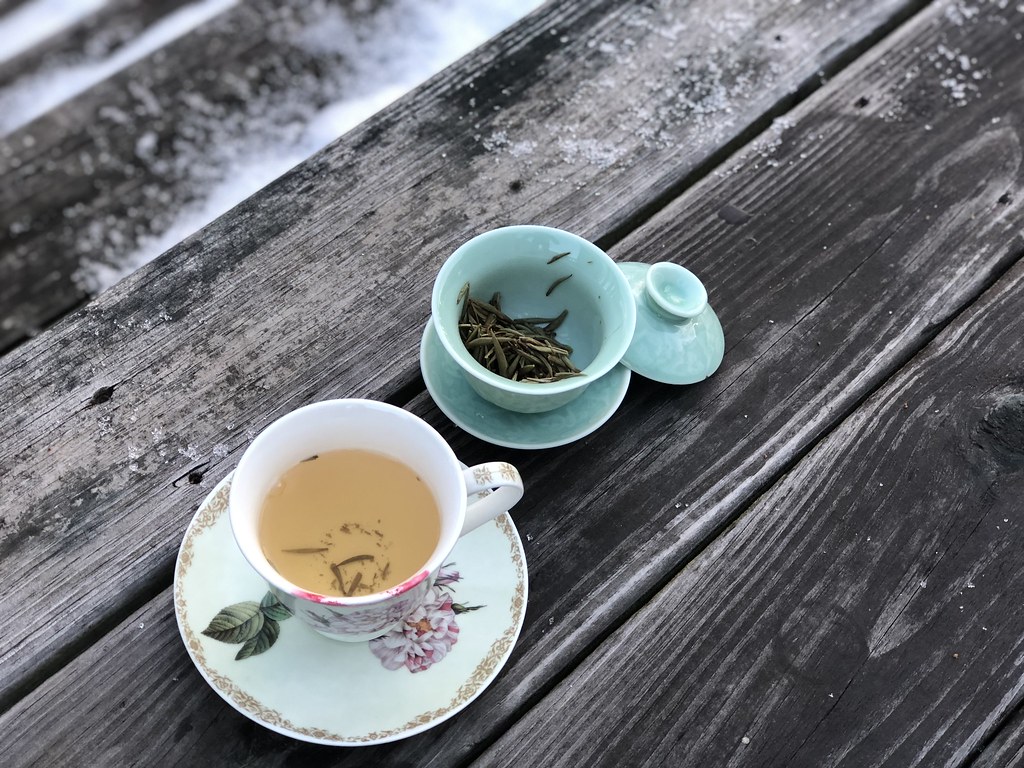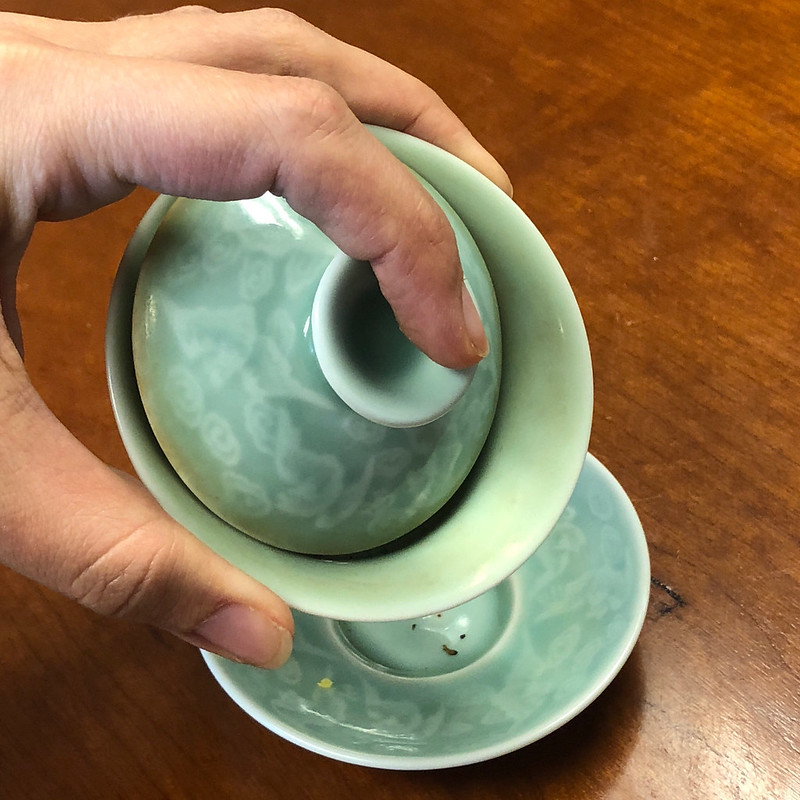As I mentioned in the prologue, the primary focus of this tea primer is true tea, made from Camellia sinensis. As such, I am loathe to consider herbal infusions or tisanes as “teas” (heck, even Benedict Cumberbatch has waded into this fray). But I do frequently enjoy infusions and tisanes of herbs and spices, and I thought I’d talk a little bit about my philosophy on herbal teas, where I get my herbs, how I prepare them, and share some of my favorite blends.
First of all, in herbals as well as teas, I prefer loose-leaf. I will use teabags in a pinch, but I find the flavor from loose-leaf herbs to be far superior. Plus, I love to create my own blends. One problem I have with commercial herbal blends is that they often contain ingredients to make them taste sweeter, or to cover the flavor of less palatable herbs. In layman’s terms, this usually means stevia, licorice root, or cinnamon, all of which I don’t particularly like. Cinnamon I can tolerate in specific blends, but only if it’s there for a reason, and not just to elevate the flavor of a blend with a particularly unpopular taste. So obviously the blends and opinions I share here will be heavily influenced by my own tastes. But the nice thing about blending your own herbal teas is that you can follow your tastes and see what works for you.
A Note About the Health Effects of Herbal Teas:
Personally, I came to herbal tea from my investigation into amateur herbalism. I’ve taken some training over the years, and done some self-study of herbal medicine, and have a decent understanding of a limited field of common herbal remedies, which I use for myself and my family members for minor complaints. Do note that I’m not a medical professional or even a licensed herbalist and I can’t give you advice on what to use for your own complaints, just a description of what works for me. I’m talking about really gentle things like ginger for an upset tummy or a cup of chamomile tea before bed.
But I think it is important to remember that herbs do have constituents that can affect our health, in both positive and negative ways. Personally, when I use herbs, I like to stick to traditional methods of ingestion: mostly infusions in water, with the occasional salve/oil/tincture/vinegar. I don’t generally take tablets or capsules of whole plants because most plants weren’t just eaten whole, unless they were food plants. Plus, I find a lot of benefit, personally, from the experience of a nice cup of tea than from popping a pill. But that’s just my preference.
All that said, most herbal teas, drunk for taste and pleasure, are probably not going to have enough plant matter in them to cause a strong reaction, unless you have a specific condition. I think it’s important to know what’s in your teas and what effects it can have, but for the most part, expecting a strong medicinal effect from the amount of plants used in a cup of herbal tisane drunk for enjoyment is unrealistic. Personally, I’ve started keeping more of an eye on this since becoming pregnant, as the body can be more sensitive to certain actions, and also I sometimes brew my loose-herb tisanes stronger than the typical cup made with a teabag.
I generally consult multiple sources to determine if there is any evidence that an herb might cause an adverse effect. Of course, almost all herbs are labeled with an obligatory “if you are pregnant or breastfeeding, consult your doctor” because there just aren’t a lot of studies of herbs on pregnant women. And similarly, there just aren’t a lot of studies of certain herbal remedies. So when I’m curious if a tea might have an adverse effect, I tend to check these three places: Mountain Rose Herbs (where I buy a lot of my herbs), Botanical.com, and WebMD.
These three resources give different layers of information. WebMD gives me information any known interactions with medication or specific medical conditions (such as the possible blood-thinning effects of chamomile). Mountain Rose Herbs usually gives a warning if there is a specific action that you should be aware of (such as using caution when taking chamomile if you are allergic to other members of the Asteraceae family, which includes ragweed). And Botanical.com gives a more complete picture of the chemical constituents of an herb, its historical usage, and how different parts are used. That said, these are not the resources I used to gain a working knowledge of using herbs for my health, but that is a topic for another time. If you’re interested in gaining more knowledge about herbal healing traditions, I’d highly recommend seeing if you have a local herb store that offers classes.
Finally, it’s important when choosing herbal tisanes and infusions to know exactly what plant you’re getting. True tea, as I’ve mentioned before, is from only one species of plant, Camellia sinensis, but herbs can have a multitude of names, and sometimes the same name can refer to different species of plants. Using the chamomile example above, “chamomile” can refer to Anthemis nobilis or Matricaria chamomilla. Fortunately, both of these have similar effects. But another example is cinnamon: what most of us have in our spice racks is actually cassia cinnamon (Cinnamomum cassia), which contains a chemical constituent called coumarin, which can have adverse effects in the body. Another kind of cinnamon, Cinnamomum verum, which is called Ceylon, sweet, or true cinnamon, doesn’t contain these coumarins. Both are sold simply as “cinnamon,” so it’s important to buy from a reputable seller who provides full Latin names if you have a condition that could interact with coumarins, to make sure you know what you’re getting (in fact, the form of cassia cinnamon sold at Mountain Rose Herbs is a third type of cinnamon, Cinnamomum burmannii, which can have even higher coumarin levels than C. cassia, but they clearly label the Latin name of the form they sell so you know what you’re getting).
So Where Do I Get Herbal Tea?
This all leads nicely into the discussion of where I source my herbs. As I mentioned, Mountain Rose Herbs is where I get a lot of my bulk herbs. If you’re very new, they sell herbs in a variety of sizes, so you can buy just an ounce or so of a bunch of different herbs. The shipping costs can be steep, but it generally balances out, and the quality is high. In particular, my absolute favorite dried peppermint comes from MRH. When you open the bag, your eyes water from the mintiness. And they ship things in thick, resealable, plastic zipper bags, so you can store your herbs in the bags they come in and be relative sure they will stay fresh. They offer a large variety of different herbs and spices and give the Latin name clearly, as well as a brief overview of uses and precautions right on the website. Plus, they have some extra things, like oils, butters, and accessories.
As I mentioned, the drawback of MRH is the shipping cost. Sometimes, if you’re only buying a little bit, the shipping cost will be as much or even more than the price of the herbs themselves. So when I’m buying small amounts of herbs to test out an herbal blend, I will often turn to Etsy sellers. In particular, for herbs, I’ve liked what I’ve gotten from Mortar and Petal, which is sadly currently closed for the holiday season. But when I was buying small amounts of herbs to test out a new blend for my pregnancy tea, I liked that I could buy just half an ounce or an ounce of a few different herbs and have them ship in a small padded envelope, rather than paying for the whole box-and-bubbles deal that comes from MRH. Plus, it’s less packing material.
But what about when I’m not in the mood to measure out loose herbs and muck about with an infuser? I’ve already admitted to using bagged tea for a real cuppa, and I will admit to drinking bagged tisanes as well. While I love my pyramid, whole-leaf bags for herbals as well as true tea, I also drink paper teabag tisanes. My favorite brands of tisanes that I can get in my store are Traditional Medicinals, Celebration Herbals, and Buddha Teas. All of these brands offer herbal “simples,” which means bags with just one kind of herb, which is nice, as well as blends. It’s important to read the ingredients lists and supplement facts for the blends to make sure you know what exactly is in the tea, though. I find that Traditional Medicinals, in particular, likes to add licorice and/or stevia to their blends to sweeten them, which I dislike. Also, other than Celebration Herbals, they’re not great about putting Latin names on the boxes sold in stores, so if you’re concerned about that, you’ll want to look them up on their websites.
But for an easy cup of tea, especially when I’m not feeling well, I like using bags. It’s also the easiest way to carry herbals around without getting sideways glances for keeping a bunch of unlabeled jars of dried leaves in your desk cabinet. And it’s basically the only way I get my husband to drink a cup of herbal tisane when he’s sick.
Finally, for spices and fresh herbs, I often just get my materials from my local grocery store. I’m fortunate to have a store nearby that sells a large variety of bulk whole spices, plus I generally try to keep a knob of ginger root on hand. And some herbs, I can grow in my wild little herb garden (mostly sage and peppermint, honestly).
Preparing Herbal Tisanes, Infusions, and Other Hot Drinks:
So first a note about terminology: Typically, a bit of plant that is put in some hot water and left to sit for a certain amount of time is called a “tea” or “tisane” or “infusion.” Some herbalists differentiate between “tisane” (or “tea”) and “infusion” by insisting that an “infusion” is a very strong steeping of an herb, meant to draw a medicinal quantity of the active constituents into the brew. I’m not quite so pedantic about, but I generally consider an infusion to be stronger than a tisane, and I also generally consider an infusion to be a cuppa brewed more for the medicinal benefit while a tisane is often just for the pleasure of it (although of course the lines blur).
There are multiple ways to make a hot drink with non-tea plant matter. Personally, I like to steep most leaves and flowers similarly to how I would steep a tea — plunk a bit of it in hot water, let it sit for a while, and then pull the leaves out and enjoy. If I want something stronger, I’ll put a large amount of plant matter in a heat-safe jar, fill with boiling water, cover and steep for an hour or more before straining. But generally, I brew a cup of “herbal tea” by taking a tea bag or 1-3 teaspoons of loose herbs and steeping them in boiling water for 5-15 minutes, depending on the plant in question. It definitely helps to play with brewing parameters with herbs because different herbs have different flavors and strength of flavors.
Now, this is for dried herbs. It is absolutely possible to make an enjoyable tisane from fresh herbs, but you have to remember two things: 1.) fresh herbs have more water content and will have less concentrated flavors, so you will need more plant matter for a brew, and 2.) fresh herbs will often have a different flavor than the dried version. For example, I love fresh thyme’s citrusy notes, but dried thyme isn’t something I enjoy. One of my favorite herbs to steep fresh is peppermint, which has a green freshness that you don’t get from the dried herb. I take a handful of fresh peppermint from my garden, wash it, and steep it in boiling water for five minutes or so, often leaving the leaves in the pot while I enjoy the tea.
But you can also make a lovely hot beverage from spices and roots, which often requires different handling. I generally make spiced teas by cracking the spices slightly and simmering them in water for 15 or so minutes to fully extract the flavor (also called a decoction). An example would be the tea I describe in this post. Simply steeping spices in hot water often doesn’t yield a strong enough flavor, although one of my favorite spice teas is thin slices of ginger root steeped in boiling water for upwards of 5-10 minutes (I just put ginger in a mug, add boiling water, and drink it grandpa-style, refilling as the ginger punch becomes too intense).
Finally, you don’t have to steep your herbs and spices in water. My favorite nightcap is a mixture of lavender and chamomile, and it is particularly nice steeped in hot milk (or milk substitute) with a little dollop of honey. I don’t let the milk boil, but I bring it up to about 165 F and let it steep for a little bit before straining out the bits of herbs. Spices are also quite nice steeped in milk.
Some of My Favorite Combinations:
Spice tea: fresh orange peel, fresh ginger, Ceylon cinnamon, allspice, and cardamom (I developed this for my chai-loving, caffeine-averse mother-in-law!)
Pregnancy tea: red raspberry leaf, rose petals, lemon and orange peel, and lemon verbena (I’ve been drinking a cup of this every day since entering my third trimester)
Gardener’s Herbal Tea: Nettles, oatstraw, red raspberry leaf, and rose hips
Lavender and chamomile tisane: 1 scant tsp. of lavender buds and 1 heaped tsp. of chamomile flowers, steeped in a mug of boiling water for 10 minutes (my go-to before bed if I’m not making the milk-steeped concoction described earlier)
Fresh mint tea: a handful of fresh mint leaves steeped liberally in boiling water (brilliant for summer afternoons, especially with a lime wheel)
Fresh ginger tea: 5-7 thin slices of fresh ginger, steeped in boiling water grandpa-style, sipped until too strong and then topped off with more water (this one is lovely with a dollop of honey and a squeeze of lemon when your throat is a little scratchy, and I generally make it to keep backstage at shows)
Sage and honey tea: 1 tsp. of dried sage or 5-7 fresh sage leaves, steeped in boiling water for 5 minutes, and then sweetened with a generous dollop of honey (this is my personal remedy for a nighttime cough)
NB: I am not a medical professional nor am I a professional herbalist and cannot give health advice concerning the use of herbs. All the teas I describe here are my personal blends and favorites and I encourage you to do your own research and find your own favorites.
